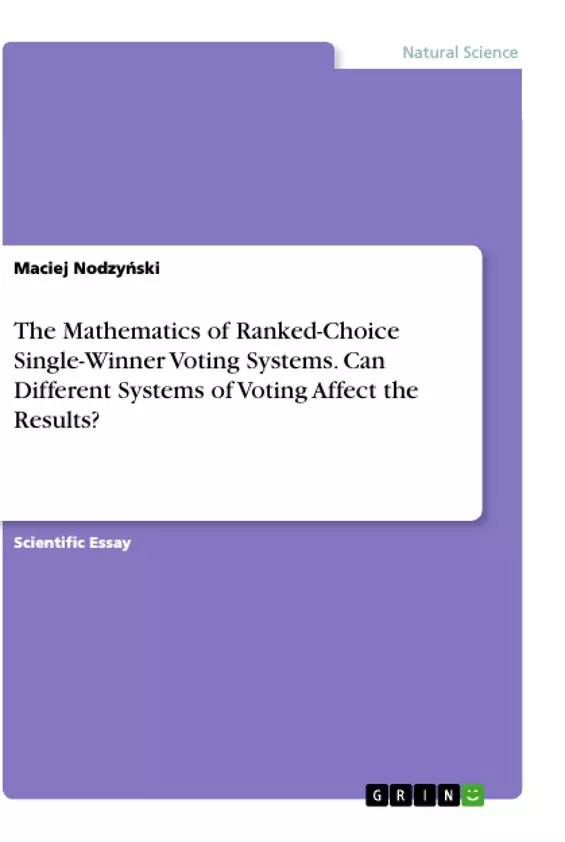The aim of this paper is to investigate to what extent different systems of voting can affect the results and the distribution of votes in single-winner elections. Moreover, during elections, there are always politicians who hold extreme beliefs and are either loved or hated by people and those who hold tempered beliefs but are tolerable by society. Consequently, the research also examines which of the two mentioned characteristics a candidate should have to increase the chances of winning by applying basic statistical measures such as mean or standard deviation.
The subject is relevant because it allows us to get a mathematical insight into single-winner electoral systems and can show whether a particular system of voting is only a tool, or directly contributes to the results. The paper analyses 4 different methods of voting that are or were used in the world to elect a President or other representatives for single-member posts: Supplementary Vote (SV), Instant-runoff voting (IRV), Bucklin Voting, and Coombs’ method.
It is worth adding that these systems are ranked-choice systems, that is voters rank their candidates from the most favorable one to the one that in their opinion is completely not suitable to accede to a particular office. Ranked-choice systems were chosen because this paper does not investigate only who wins the election but also how the situation of candidates in other positions changes.
Inhaltsverzeichnis (Table of Contents)
- Introduction
- Procedure
- Supplementary Vote (SV)
- Instant-runoff Voting (IRV)
- Bucklin Voting
- Coombs' method
- Conclusion
Zielsetzung und Themenschwerpunkte (Objectives and Key Themes)
This paper aims to examine the impact of different ranked-choice voting systems on single-winner elections, specifically in the context of presidential elections. The research investigates how these systems can affect both the election results and the distribution of votes. Additionally, the paper analyzes whether candidates with extreme beliefs or more moderate beliefs have a higher likelihood of winning under different voting systems.
- Influence of ranked-choice voting systems on election outcomes
- Distribution of votes under different voting systems
- Impact of candidate beliefs (extreme vs. moderate) on electoral success
- Mathematical analysis of single-winner electoral systems
- Exploration of ranked-choice systems in real-world elections
Zusammenfassung der Kapitel (Chapter Summaries)
- Introduction: The chapter introduces the topic of mathematical applications in politics, specifically focusing on the impact of different voting systems on single-winner elections. The paper's objectives and key themes are outlined, highlighting the importance of analyzing the effectiveness and fairness of various electoral systems.
- Procedure: This chapter details the methodology used to conduct the research. An anonymous poll was conducted, gathering data from a representative sample of Polish citizens aged 18 to 56. The poll involved ranking six prominent presidential candidates according to voter preference. The chapter explains the data collection process, ensuring transparency and reliability of the results.
- Supplementary Vote (SV): This chapter focuses on the Supplementary Vote (SV) system. It analyzes the results of the survey data when applying the SV system to the six presidential candidates. The chapter discusses the strengths and weaknesses of the SV system, examining its impact on the distribution of votes and the likelihood of different candidates winning.
- Instant-runoff Voting (IRV): Similar to the previous chapter, this chapter explores the Instant-runoff Voting (IRV) system. It applies the IRV system to the survey data, evaluating its effectiveness in determining a clear winner and its impact on the overall voting process. The analysis focuses on the strengths and weaknesses of IRV, highlighting its advantages and potential drawbacks in the context of single-winner elections.
- Bucklin Voting: This chapter delves into the Bucklin Voting system, investigating its application to the survey data. The chapter examines the potential of the Bucklin system to produce a clear winner while minimizing the influence of strategic voting. It explores the system's effectiveness in representing voter preferences and its overall impact on the election outcome.
- Coombs' method: This chapter focuses on Coombs' method, analyzing its application to the survey data. The chapter explores how Coombs' method operates and its potential for achieving a consensus among voters. It examines the strengths and limitations of the system, considering its impact on the distribution of votes and the determination of a winner.
Schlüsselwörter (Keywords)
The core keywords and focus topics of this paper include ranked-choice voting systems, single-winner elections, electoral systems, voting preferences, voter behavior, candidate beliefs, presidential elections, statistical analysis, mean, standard deviation, and electoral manipulation.
- Quote paper
- Maciej Nodzyński (Author), 2021, The Mathematics of Ranked-Choice Single-Winner Voting Systems. Can Different Systems of Voting Affect the Results?, Munich, GRIN Verlag, https://www.hausarbeiten.de/document/1059528


